Often dubbed as “rare,” rare earth metals are far from scarce; rather, their name can be misleading. With a total of 17 critical elements, including neodymium and europium, these metals are indispensable for the fabric of modern technology. From enabling smartphones to function and powering electric vehicles to facilitating renewable energy technologies such as wind turbines, rare earth metals are at the core of our digital and energy transition. However, the pressing issue of supply chain reliability looms large, especially for countries like those in Europe that depend heavily on imports from China. As the global demand for sophisticated technologies rises, so does the urgency to address both the sourcing and sustainability concerns surrounding these vital resources.
The Challenges of Extraction
The extraction of rare earth metals is riddled with complications. Naturally, these elements exist in compound forms within ores, making their separation a challenging endeavor. The chemical similarities among these elements necessitate intricate and often environmentally costly separation processes, which involve numerous extraction steps. Traditional methods are not only energy-intensive but also generate significant amounts of waste, posing a daunting environmental challenge.
The alarming truth is that Europe is currently failing to implement an effective recycling mechanism for rare earth metals, contributing to both resource wastage and economic inefficiency. Victor Mougel, a prominent figure in the field of inorganic chemistry, pointedly remarks on this issue, highlighting a critical need for innovative solutions that bolster recycling efforts. As the reliance on rare earth metals escalates, the pursuit of sustainable methods for their recovery becomes not just a technological challenge but an ethical imperative.
Innovative Solutions Inspired by Nature
In light of these challenges, researchers led by Mougel have embarked on a groundbreaking study that promises to change the narrative surrounding rare earth metal recovery. A recent publication in *Nature Communications* unveils an innovative and simplified method for the extraction of europium—a rare earth metal that has traditionally posed difficulties in separation due to its proximity to other elements in chemical properties.
Central to this innovative approach is the use of tetrathiometallates, small inorganic molecules that are inspired by biological processes. These tetrathiometallates, which contain four sulfur atoms surrounding a tungsten or molybdenum center, serve an important function akin to binding sites found in natural enzymes. Their redox properties allow for the efficient reduction of europium to a more separable divalent state, drastically streamlining the recovery process. Remarkably, this new technique yields europium in quantities that can exceed previous methods by a staggering 50-fold, a game-changer for recycling initiatives.
From Waste to Resource: Rethinking E-Waste Management
In the quest for recycling rare earth metals, electronic waste emerges as a treasure trove of untapped resources. Mougel emphasizes that countries like Switzerland could potentially transform their waste management practices by recycling materials that are currently discarded. Specifically, the waste from fluorescent lamps, once relegated to landfills, harbors europium in concentrations reportedly 17 times higher than found in conventional ores.
With the global trend moving away from traditional fluorescent lamps, demand for europium has plummeted, thereby making older recycling methods obsolete. However, the introduction of new, more effective separation techniques not only revives the economic viability of europium recycling but also offers a pathway to reduce dependence on foreign imports. By treating electronic waste as an “urban mine,” we can not only reclaim valuable resources but follow a circular economy approach that minimizes environmental impact.
Future Prospects and Sustainable Industry Growth
The implications of these innovations extend beyond just scientific interest; they represent a crucial shift toward a more sustainable industrial landscape. The researchers behind the new separation technology are not content to stop with europium—they are ambitiously pursuing adaptations for other rare earth elements like neodymium and dysprosium. This push for broader applicability holds the promise of a more harmonious relationship between technology and the environment.
In a world increasingly aware of its ecological footprints, the quest to recycle and reuse precious resources becomes a moral imperative, seamlessly aligning environmental sustainability with economic opportunity. By establishing a start-up named REEcover, the research team aims to commercialize this technology, ensuring that efficient recycling methods become a staple rather than an exception.
While the road ahead may be paved with challenges, the proactive steps taken to address the rarity of these vital metals through recycling and recovery speak to a transformative future that champions both innovation and sustainability.


Leave a Reply